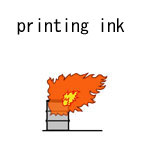| Case Name |
Fire of a printing ink at the dryer of a rotary press |
| Pictograph |

|
| Date |
July 24, 1989 |
| Place |
Sagamihara, Kanagawa, Japan |
| Location |
Printing factory |
| Overview |
The rotary press consisted of four units (one unit comprised a printing machine and a drier). When a roll of paper was consumed, another roll of paper was inserted. During this work, the pull roller generated a gap, the paper was not wound sufficiently at re-start, and was immersed in the ink tray. At the heater of the press, droplets of excess ink fell and were heated by the high-temperature heater. Thus a fire occurred. |
| Incident |
Ink droplets fell at the drier of a printing machine. They were heated by the heater of the drier, and ignited. 220 L of ink burned. Usually, printing ink is combustible, and it is designated as a dangerous material under the Fire Protection Law. |
| Processing |
Consumption and usage |
| Individual Process |
Drying and desiccation |
| Substance |
Printing ink |
| Type of Accident |
Fire |
| Sequence |
1. A roll of paper was replaced by a new one at the rotary press.
2. The paper was immersed in the ink tray because a gap was generated by the pull roller when printing restarted.
3. When excess printing ink entered the drier of the printing machine, it dropped from the paper. The ink was heated, and ignited. |
| Cause |
On replacing paper, the paper was not taut and it absorbed ink excessively. The excess ink fell into the drier, and was ignited in radiant heat. |
| Countermeasures |
As there might be some defects in the printing equipment, improvements are necessary.
Simultaneously, it might be necessary for workers to recognize that they are handling very dangerous combustibles. |
| Knowledge Comment |
Ink might not be immediately recognized as a dangerous material like gasoline and kerosene, but ink is a dangerous material because it mainly contains toluene. It is necessary for workers and managers to recognize that they are handling a very dangerous material. |
| Background |
Ink solvent is mainly composed of toluene, so ink should to be treated with the same care as toluene. It is doubtful whether the workers handling the ink knew this fact. In other words, it seemed they handled the ink with no education or training on dangerous materials.
If the machine was improved or the operation was changed so that the paper would not enter the ink tray, the accident would not have occurred. The machine might have had an improper structure for handling a dangerous material. |
| Reason for Adding to DB |
Example of fire caused due to a lack of consciousness of dangerous materials |
| Scenario |
| Primary Scenario
|
Poor Value Perception, Poor Safety Awareness, Inadequate Risk Recognition, Ignorance, Insufficient Knowledge, Insufficient Study, Organizational Problems, Poor Management, Slackness of Management, Usage, Operation/Use, Operation of Printing Machine, Regular Operation, Nonobservance of Procedure, No Confirmation, Bad Event, Chemical Phenomenon, Burning, Secondary Damage, External Damage, Fire, Loss to Organization, Economic Loss, Direct Monetary Damage 45million yen
|
|
| Sources |
Fire and Disaster Management Agency, Major cases of accidents, Fire at dryer of rotary press. Accident cases of dangerous materials, pp.33, 266-267.
|
| Physical Damage |
A 120 square m factory was destroyed by fire. (A rotary press, an air conditioner, an attic) 220 L of ink burned. |
| Financial Cost |
¥45 million (Accident cases of dangerous materials) |
| Field |
Chemicals and Plants
|
| Author |
KOSEKI, Hirosi (National Research Institute of Fire and Disaster)
TAMURA, Masamitsu (Center for Risk Management and Safety Sciences, Yokohama National University)
|
|